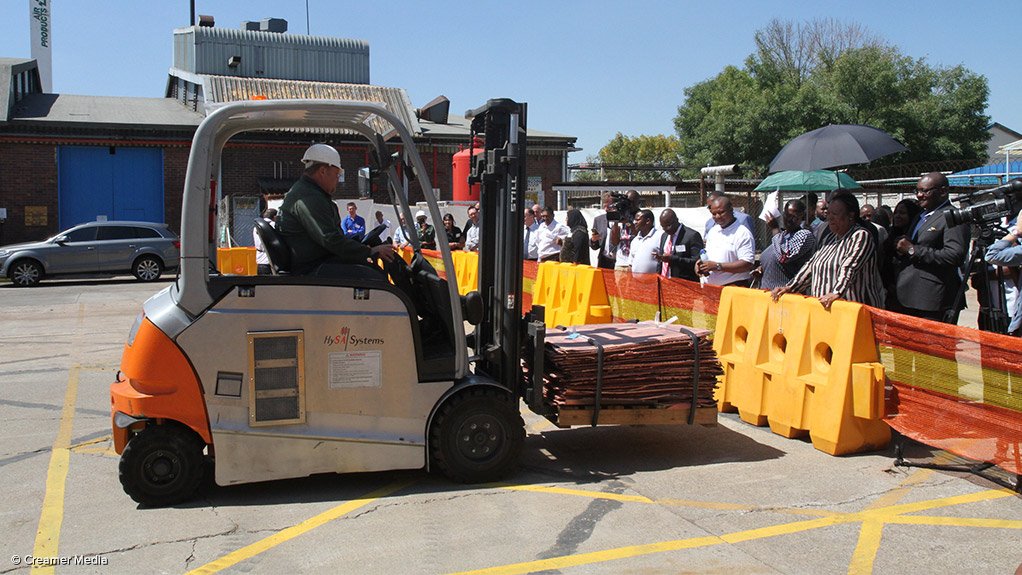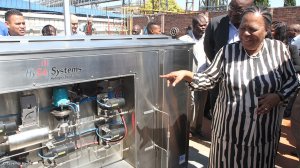SPRINGS (miningweekly.com) – Platinum mining company Impala Platinum (Implats) on Thursday unveiled a hydrogen fuel cell forklift and hydrogen refuelling station in the presence of Science and Technology Minister Naledi Pandor and Gauteng Premier David Makhura at the Impala Refineries in Springs.
The R12-million initiative, undertaken in partnership with the University of the Western Cape (UWC), focuses on building local skills in the development of platinum-using fuel cells.
Thursday also marked the first anniversary of the Chamber of Mines (CoM) launching the first 100 kW fuel cell, which makes use of Implats' platinum.
The chmaber believes that the platinum-using fuel cell industry has the potential to revolutionise the way electricity is used to drive cars, provide off-grid power to homes, energise mobile phones and light up office blocks.
Under the strong leadership of CEO Terence Goodlace, Implats is taking firm strides to help establish fuel cells on a commercial footing that would place new demands on the platinum company mines.
It is also at an advanced stage of studying the feasibility of taking its entire platinum refinery off the national electricity grid and powering it with platinum fuel cells.
The prototype hydrogen fuel cell forklift and refuelling station are the fruit of a three-year collaborative effort also involving Hydrogen South Africa (HySA) Systems and comprising a local supply chain that includes Hot Platinum, TF Designs, Air Products and Sasol, which provides the hydrogen.
Over the last three years, HySA Systems has received R6-million from Implats to develop the fuel cell-powered prototype forklift and refuelling station.
The mining company also plans to use fuel cell technology as its main source of energy for underground mining equipment.
Implats’ partnership with the UWC’s South African Institute for Advanced Materials Chemistry falls under the leadership of Professor Vladimir Linkov, who describes the tie-up as being “unique in the national system of innovation”.
Impala Refining Services fuel cell coordinator Fahmida Smith described the new applications as exciting developments in the drive towards providing carbon-neutral fuel sources for Implats operations.
Fuel cells, which provide electricity cleanly and quietly, will improve ventilation in underground mines as well as reduce heat, noise levels, and noxious and sulphide emissions.
South Africa and Zimbabwe host more than 80% of the world’s known platinum resources and are able to provide the platinum needed for fuel cells.
The technology’s demand for the use of platinum provides additional avenues for beneficiation and environmental protection.
METAL HYDRIDE STORAGE SYSTEM
A metal hydride hydrogen storage system – which also makes use of local metals including titanium, nickel and rare earths – allows the forklifts to operate at lower pressures of 190 Bar, which improves safety and brings the cost of refuelling stations down to R2-million compared with the €500 000 for international systems.
The low-noise fuel cell forklifts work with sufficient fuel for two to four days’ operation before hydrogen refuelling is required - a process that takes seven minutes.
HySA Systems director Dr Cordellia Sita noted that the challenges of limited refuelling infrastructure and the discovery of the most appropriate on-board hydrogen storage technology had been met through the use of the metal hydride material for both hydrogen compression and storage.
Goodlace noted that developing a viable fuel cell industry in South Africa had several advantages for the country such as economic development, sustainable job creation and social good.
“As the world’s largest platinum supplying region there is a guaranteed supply of the metal as well as the potential to increase global platinum demand,” he said at the presentation attended by Creamer Media’s Mining Weekly Online.
Southern Africa’s hosting of an overwhelming volume of the platinum on the planet makes the local manufacture of platinum-using fuel cells an exciting possibility to drive economic development and sustainable job creation.
Southern Africa’s hosting of an overwhelming volume of the platinum on the planet makes the local manufacture of platinum-using fuel cells an exciting possibility to drive economic development and sustainable job creation.
By developing fuel cells locally, South Africa could also play a leading role in reducing global greenhouse gas emissions and further containing local pollutants.
PGMs remain South Africa’s second-largest export revenue generators and contribute more than 10% of national taxes collected.
Collectively, South Africa’s platinum mines provide direct employment to 136 000 people or 26% of all mining employees.
Taking into account the businesses that the PGMs industry serves and the businesses that serve the PGMs industry by selling to mines, the platinum sector supports at least another 325 000 jobs.
Combined, PGMs support more than 450 000 individuals each with some four to ten dependents.
Considering these national benefits, it is certainly an industry that is worth nurturing.
Makhura emphasised that South Africa’s reindustrialisation would benefit from the development and implementation of fuel cell technology, which provided an opportunity for the country and the province to play a leading role in reducing global greenhouse gas emissions and containing urban pollutants.
Goodlace said that Implats planned to fast-track the local manufacture of fuel cells and the associated components within a proposed tributary special economic zone (SEZ) in the Springs region, which would be a satellite to the new SEZ at OR Tambo International Airport.
The company’s localisation strategy envisages partnerships with international manufacturers and, in time, the backward integration of local South African subcomponents.
Fuel cells are chemical devices that operate at temperatures of up to 1 000 ◦C to transform hydrogen and oxygen into electricity, heat and water in the presence of platinum, which acts as a catalyst.
Hydrogen fuel cell technology provides low to zero emissions depending on energy production sources, reliability, virtual noiselessness due to the absence of moving parts, efficiency and flexibility.
Not only can hydrogen fuel cells be used for a variety of applications; they can also operate on a wide load range and scale from micro-production to megawatt production.
Implats’ Impala, Zimplats, Marula, Mimosa and Two Rivers mines are located on South Africa’s Bushveld Complex and Zimbabwe’s Great Dyke.
The CoM said in a media release that it would continue to demonstrate the potential for local manufacture and the industrial use of platinum in South Africa and Africa.
It would also promote platinum beneficiation, capture and sustain technical and operational fuel cell knowledge and unlock South Africa’s natural resources through the use of natural gas and platinum.
The chamber described fuel cell technology as being aligned with its commitment, made at last year's twenty-first Conference of the Parties, to creatie a more environmentally sustainable future.
The platinum fuel cell that the CoM’s offices operate in the Johannesburg central business district uses low-pressure natural gas.
Edited by: Creamer Media Reporter
EMAIL THIS ARTICLE SAVE THIS ARTICLE
To subscribe email subscriptions@creamermedia.co.za or click here
To advertise email advertising@creamermedia.co.za or click here
















